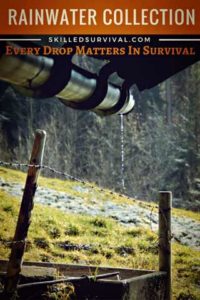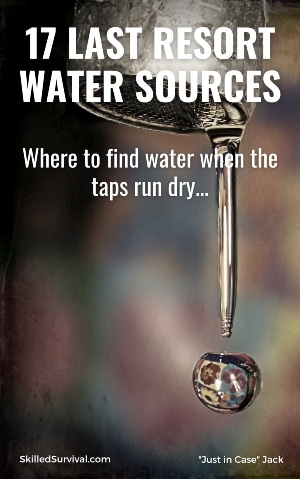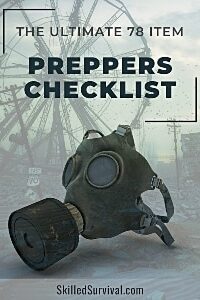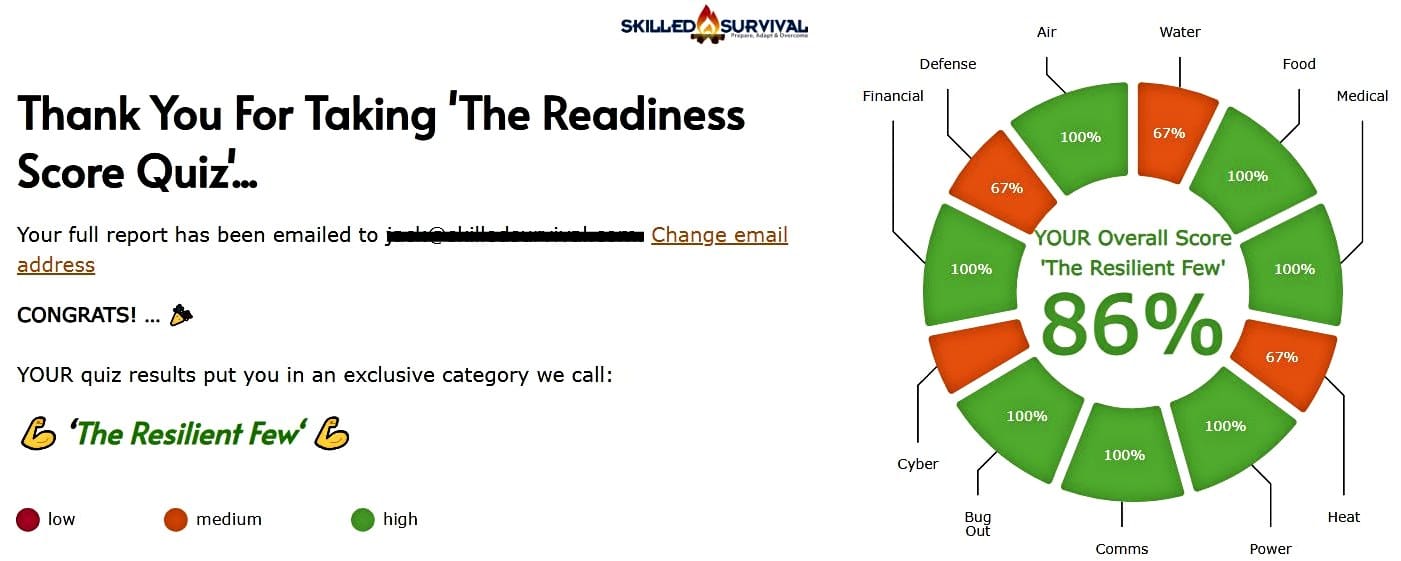
A Complete Guide On How To Build A Rainwater Collection System
When a resource as valuable as water is both free (via rain) and collectible, you take advantage of it.
TOPICS IN THIS GUIDE… ↓(click to jump)
- Best Rainwater Collection Options
- Build a Rain Water Collection System
- Rain Barrel Mosquito Management
- Done-For-You Harvesting System
- The Legality Of Harvesting Rainwater
- BONUS: But What If There’s No Rain?

Want a free last resort water checklist?
Enter your email below to instantly download this Complete Checklist PDF. No purchase necessary. 👇 👇Best Rainwater Collection Options
Water collection is as old a skill as we’ve ever known – older than fire, even.
Of course, as time has gone on, our methods have become less rudimentary and more refined.
We’ve been doing this for hundreds of thousands of years; so, naturally, we’ve gotten pretty good at it.
There are several schools of thought and techniques to approach rainwater collection.
Some are Eastern, some are Western, some are good, some are bad, and others are ugly.
But they all tend to revolve around the same core set of principles:
1. The bigger the surface area, the more water you can collect.
2. Water that’s collected is transported efficiently.
3. Water that’s transported gets filtered.
A jerry-rigged system that accomplishes these three principles, is all you need.
But we can also do better than that.
So I’ve compiled a list of rainwater collection methods.
There are two routes you can take to accomplish efficient rainwater harvesting: build your own or buy one.
Building a Rain Water Collection System
Improvising a Rainwater Harvesting System
With the three principles listed above, you need a large surface area, transportation, and filtration.
I have seen people use tarps to create a funnel for the water, and a bucket at the bottom to catch it in.
A setup like this works best if you’re not allowed to tap into your roof for water collection.
For instance, if you live in a condominium or an apartment building.
↓ Rain Collection – Quick Deploying Rain Catchment
In the wild, broad leaves can also work if you find yourself surrounded by them.
It is also possible to open up and hang a rain jacket or rain cover so that it collects and transports the water.
Hell, even using saran wrap, unrolled and spread out can work in a pinch.
Building a Stationary, Permanent Rainwater Harvesting System
If you want to create your rainwater collection system at your house, you need supplies.
Luckily, your roof, is one of the best collection tools available.
They’re a big surface area and funnel rainwater down toward a central location.
A roof with gutters takes care of the first principle.
There are many ways to do roof-based rainwater collection; the methods below describe a few.

Want a free 78 item prepper checklist?
Enter your email below to instantly download this Complete Checklist PDF. No purchase necessary. 👇 👇The Basic “No Extras” Rainwater Collection System
As with most permanent rain collection set-ups, this one also uses your existing roof and gutters.
And this basic setup only requires 1 additional item:
A New Rainwater Barrel (like this one)
Or even a collapsible rain barrel (like these).
Note of Caution: Never reuse an old barrel.
Especially if you don’t know what was stored in it in the past.
This is life-giving water you may need to consume someday. So the last thing you want to use is a barrel that once held oil or chemicals.
You also should buy a barrel that includes a standard spigot at the bottom, and a lid with an opening at the top (with a mesh screen). And an overflow port as well.
Having these features preinstalled in your barrel will save you a ton of headaches.
Note: You’ll need a garden hose to connect to your spigot if you don’t already own one.
How To Build This Simple Rainwater Collection System
Step 1.
Measure the height of your rain barrel so you know where to make a cut in your downspout.
Ultimately you want to use your existing downspout elbow near the ground and move it up to be just high enough for the barrel to fit under it.
Step 2.
Using a hacksaw cut the gutter.
Step 3.
Relocate your gutter elbow located near the ground up to the freshly cut location.
Step 4.
Once the elbow has been relocated, place the barrel under the gutter system on a flat surface.
You need to barrel to be close enough to the gutter for the water from the elbow to flow into it.
That’s it.
You don’t need to make it more complex or difficult than it needs to be.
Anyone can do this simple rainwater collection setup.
↓ The BEST DIY Rain Barrel Install Complete Guide
It’s also preferable to install the barrel on a surface made of concrete or paving stones or gravel.
This helps ensure stability since a full 55-gallon rain barrel can weigh nearly 500 lbs. (barrel and water weight combined).
If it’s installed on a slope of any kind it can tip over and hurt someone.
And if it’s on the bare ground it can sink and make a muddy mess over time.
That’s it.
You now have a bonafide method for collecting rainwater right from your roof.
Note of caution:
If you live in a climate that receives freezing temperatures in the winter.
It’s best to empty your barrel for the season to prevent the water from freezing, expanding, and destroying your barrel.

Want a free 78 item prepper checklist?
Enter your email below to instantly download this Complete Checklist PDF. No purchase necessary. 👇 👇Building A Complex Collection System
You can expand upon this basic rainwater collection system and make it larger and more complex.
If you want to increase the amount of survival water storage you have 2 options:
1. One Large Tank
The first option is to get a larger barrel, tank, or cistern.
Note, the bigger your tank, the more likely you’ll have to reconfigure your gutters and add a diverter kit to the larger barrels.
I’ve seen people use old hot tubs or large plastic tanks to collect water.
In some cases, you may prefer to build a separate roofing system just to collect the rainwater into such a large tank.
The principles are the same, it’s just a larger system.
↓ Rainwater Harvesting Off Grid
↓ How I Capture 5,750+ Gallons of Rainwater For My Garden
2. Several Smaller Barrels Tied Together
Or if you’re not into going large with a massive tank right away, you have the option to grow your system over time.
You can daisy chain smaller 55-gallon-sized barrels together.
This setup, when installed correctly will add extra water capacity by distributing the water storage into more tanks.
What I like best about this approach is you can start today with a reasonable upfront investment and grow your system barrel by barrel over time.
It’s a win-win.
You can then add as many separate barrels linked together with hoses as you wish.
Here’s an excellent explanation of how a daisy-chained rainwater collection system should work.
↓ Make Rainwater Tanks From Pickle Barrels
Did you notice that better collection systems are up on a platform?
That’s to provide a nice level surface, to keep the barrels clean and dry, and to provide a bit more water pressure at the base of the tank using gravity.
So consider buying or building an elevated platform.
You can do this with a few cinder blocks or build a platform out of wood.
↓ Rain Barrel System 2120 Gallons SHTF Water Storage
Adding A Pump
Another upgrade worth adding is a submersible solar water pump.
A pump gives you water pressure without depending on gravity.
So you can use your water at further locations or even pipe the collected rainwater to a new location (even to inside your home).
↓ The Rain Barrel Pumping Station – Building and “Debugging”
Water Pillow Rainwater Collection Option
The last option we’ll look at today is a rainwater pillow.
This pillow is the equivalent water storage of about 10 55-gallon barrels.
So instead of daisy-chaining 13 barrels together, you can use one water pillow (assuming you have a good place to locate it).
Keep in mind you’ll still want to filter and purify any rainwater from your roof.
Roofs are Dirty
They collect bird and squirrel droppings, road dust settles on them during long periods without rain, and leaf debris can build as well.
So always filter and purify the water if you intend to use any of it for cooking or consumption.
Sawyer Mini Water Filter
I highly recommend you get a couple sawyer mini water filters.
Wait? Mini? A mini water filter?
Yes, it’s mini in size but not in volume.
It can filter 100,000 gallons of water!
This little water filter is ideal for both travel AND building a large capacity volume gravity filter at home.
Perfect for your water storage plan.
What makes the Sawyer Mini so powerful is its inline design capabilities.
You can use a simple rubber hose to add a Sawyer Mini between your water storage containers and create a large completely passive gravity filter with a single Sawyer Mini.
Saving you hundreds of dollars vs traditional gravity water filters!
Here’s my review video of the Sawyer Mini.
↓ Sawyer Mini Water Filter Review
Rain Barrel Mosquito Management
Mosquitos breed like crazy in open stagnate water.
That’s why you should pick up a few packs of Mosquito dunks to prevent creating a mosquito infestation haven.
Your neighbors will appreciate it.
↓ Tips For Keeping Rain Barrels Mosquito Free
“Done For You” Rain Harvesting System
Having an entire rainwater collection system installed for you is a budgetary decision.
How much time and money do you want to spend on your rainwater collector?
If you want to save a few bucks and invest a little more heavily in time, you should build your own.
However, if you have the cash to burn and no time to spare, buying one is a better option for you.
Plus, it ensures you collect and filter water in an efficient manner.
Normally, there’s less chance of error with a “done for you” installation.
But you still have the responsibility of maintaining it.
↓ Collecting Rainwater – Cleaning and Maintenance
Many vendors specialize in rainwater harvesting systems and most provide a variety of setups.
So you’ll have to weigh your options and decide what’s best for you.
Start by asking a few fundamental questions:
- How much water do you use?
- What are the rainfall averages in your area?
- How much money do you have to spend?
- What are you going to use the water for?
You’ll need to contact a local rainwater harvesting vendor in your area.
Then see what options they have for you.

Want a free 78 item prepper checklist?
Enter your email below to instantly download this Complete Checklist PDF. No purchase necessary. 👇 👇The Legality Of Harvesting Rainwater
Myths abound surrounding the legality of rainwater collection in the US.
I’ve heard it said it’s illegal almost everywhere.
This statement is ill-informed and ludicrous to me because well…it is.
Collecting rainwater is legal in most states.
However, each state has its own nuances and specific rules around the collection of rainwater.
So, of course, you should check the legality in your state.
But in general, it’s a legal thing to do.
In my opinion, collecting rainwater should be a human right – and it should stay that way.
However, there’s no telling the kinds of restrictive policies governments may put in place in the future.
Perhaps someday, our government will start enforcing stricter policies on collecting rainwater.
And that would be a shame and unacceptable.
No one owns the rain.
It comes from above and every generation across time has had free and unadulterated access to it.
If the powers that be ever threaten this precious resource, we the people should do something about it.
Until then, feel free to collect rainwater on your property as you wish.
But keep a watchful eye on your state’s policies and laws, and those of your municipality.
BONUS: But What If There’s No Rain?
It’s a good question.
Rain collection does not work without the key ingredient; rain. So we can simply call this section “water collection.”
Obviously, digging is one way to find water.
It depends on the location, season, and recent weather.
But if you dig deep enough, you’ll get to water eventually just about anywhere.
In some areas, the water table is very shallow (a few feet deep) while in other areas you’ll have to dig hundreds of feet deep.
So the viability of this option is location-dependent.
Morning dew is also an option.
You can collect natural humidity called dew off vegetation in the mornings.
In some locations, dew blankets the grass in the mornings.
That’s what you’re going to try and collect.
↓ Survival Water Purification Collecting Dew
The Final Word
Oil, gas, and even survival gold all pale in comparison to the real survival value of fresh drinking water in a collapsed society.
It’s the stuff of all living things.
It’s so essential, in fact, that astronomers search for water on other planets more than other chemicals for signs of life.
We wouldn’t exist without our best friend, H2O.
Without water, human beings would shrivel up like raisins.
We’d die like a plant in a severe drought.
So learning how to collect a sustainable source of drinking water is a vital survival skill.
Honestly, no one cares that you can fell a tree in under 5 minutes?
At least not when there’s no water around.
“Big deal” if you can catch, skin, and cook a rabbit in under an hour?
Food cannot save you from dying of thirst.
In fact, the human body can typically survive three weeks (or more) without food!
Mahatma Gandhi survived a full 21 days of total starvation.
But three days without hydration and you’ll kick the bucket.
Good-bye.
But we tend to take water for granted.
Turn on your taps and out pours water.
We’ve forgotten (or likely never experienced) true water deprivation.
Benjamin Franklin summed it up best with his quote,
“When the well is dry, we know the worth of water”
Luckily, there’s an effective method for collecting a source of drinking water.
And it comes from the sky.
Even though our society depends on tap water, we can still collect rainwater.
So it may become one of the most tradable items on Earth.
I wouldn’t be surprised if the economy were someday restructured around water.
Should that be the case, it makes sense to invest in a rainwater collection system today.
One that produces and regenerates drinking water on a sustainable basis.
Rainwater collection is like life insurance. Because water is necessary and without it, you die.
A rainwater collection system ensures you have a built-in water supply.
It can mean the difference between life and death.
The bottom line is you’re not totally ready, and you’re not fully prepared without having a rainwater harvesting system in place.
It will be worth it in the end, trust me.
Why Trust Skilled Survival...
Go here now to review a full breakdown of:
- Who We Are
- Our Credentials
- Our Mission
- & Product Recommendations...
Here are a few highlights of our teams credentials & certifications:
- Certified Member of a Mountain Search & Rescue Organization
- Plant Emergency & Safety Leader for a Major Food Manufacturer
- Member of the 10TH Mountain Division Hut Association
- Certifications: Avalanche 1, WFR, CPR
- Official Gear Tester for Numerous Outdoor Gear Companies
- Countless Multiday Backpacking trips into Remote Wilderness
- Bachelor's Degree In Mechanical Engineering
- Bachelor's Degree In Civil Engineering
- Bachelor's Degree In Biomedical Engineering
"It takes 20 years to build a reputation and five minutes to ruin it." - Warren Buffett
We're fully aware that trust is NOT something you GET but is EARNED.
And we'll continue to earn YOUR trust through our forthright and honest approach with each new Blog Post, Guide & Product we create...
Will Brendza


AND... I've still got a few gaps in my preps...🤔 But at least, I'm not part of 'The Fragile Masses'. 👍 Find out where YOU stand by answering a few questions...

Recommended Reading
Best Fuel Storage Ideas: How To Store Extra Gasoline
Long term fuel storage is crucial in all survival situations, but fuels must be stored properly and safely to keep, especially long term gasoline storage.
How To Store Seeds For Wise Prepping & Survival
When seed saving and seed storage, you must do it right. Learn how to store seeds so they'll thrive the next planting season.
Common Everyday Carry Mistakes YOU Must Avoid At All Costs
The only person qualified to build YOUR Best Everyday Carry (EDC) is YOU. To do it right, you must avoid these common mistakes and pitfalls.
Strategic Relocation: How To Find A Safe Pace To Live
Use strategic relocation to find a safe, defendable location to call home. Your choice of location WILL determine your survival fate.
Map Of Nuclear Fallout: Would I Survive A Nuclear Bomb?
Have you seen a map of nuclear fallout? Or run a nuclear simulation to see the damage a nuke would do to your city? If not, check this out.
Homestead Survival: How To Master Plan Your Own Safe Haven
Use this simple 6 step action plan to successfully plan and build a homestead to survive (and thrive) even if the world falls into chaos...



